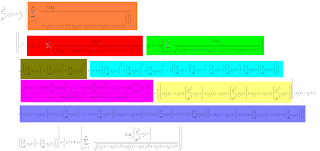During the experiment “The effect of black hole passing by our solar” using NCGS, I was advised to include relativistic effect into the simulator, to see if something can be different. Therefore this blog is intended as a starting plan to make a new simulator called PPNCGS. Just to make sure I get the meaning of equation [8-1] from http://iau-comm4.jpl.nasa.gov/XSChap8.pdf right.
Parameterized Post Newtonian Collision less Gravity Simulator (PPNCGS), is an upgrade planned for simple Newtonian Collision less Gravity Simulator. By including the Parameterized Post Newtonian into the equation, the relativistic effect can be included into the n-body interaction in an NCGS. So, instead of only the value of G like in NCGS, the other cosmological constant, c will also be included in the simulator.
The original equation [8-1] from http://iau-comm4.jpl.nasa.gov/XSChap8.pdf is this :
Then we remove the asteroid calculation,
From here on this equation will be called equation A1
First we will need to make the equation, more computer friendly. Even if mathematically a*b+a*c = a*(b+c) , these two are not the same computationally. Multiplication need more time to process than addition, so a*b+a*c will need more time to process than a(b+c). Therefore, we simplify this equation to become equation A2, by collecting c from equation A1.
Then we by using the law of distribution, we simplify the red boxed part of equation A2, to become equation A3.

In order to find the derivative of the function, we might need to use software called, Maple. In order to make the equation Maple readable, we must turn Equation A4 into Equation A5. Since Equation A5, is really complex (but Maple readable), I put some color on it to denote relationships between equation A4 and A5. (click image for detail)


After equation A5 have been checked for their compatibility with Equation A1, we will go further to the next step of making calculation network design (required to minimize the number of calculation required).
The other thing that must be done is to find the derivative of acceleration, as the numerical method used in the PPNCGS is Taylor Second Order.
Download NCGS Program and Source Code here






2 comments:
In equation A1, consider the first "1". When you write A2, this should become c^2. In error, it still appears as "1".
The r-dot-dot on the right hand side is not exactly the same as on the left hand side. Instead, it is just the Newtonian effect. That is, r-dot-dot (right side) = SUM[j not= i] {mu(j) (r(j)-r(i)) / r(i,j)^3. I hope you can read that, because I do not know how to get math equations in this little box.
Ah yes, you were right. The thing that make me wonder is why equation A5 is right when equation A2 is wrong.
About the r-dot-dot in the right hand side, didn't I supposed to do some repetition until the value converge ?
Post a Comment